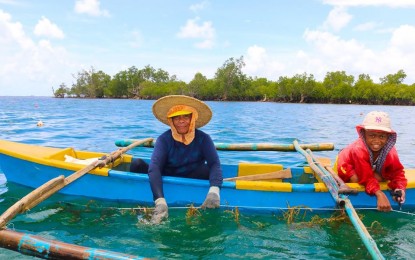
RED TIDE. Fisherfolk are hard at work in Matarinao Bay in General MacArthur, Eastern Samar, in this undated photo. The Bureau of Fisheries and Aquatic Resources on Tuesday (Sept. 2, 2025) said three bays in Eastern Visayas, including Matarinao, are still affected by the toxic red tide. (File photo)
TACLOBAN CITY – Three bays in Eastern Visayas are still affected by the toxic red tide, the Bureau of Fisheries and Aquatic Resources (BFAR) reported on Tuesday.
Based on an examination of shellfish and seawater samples, three bodies of water were found to have toxic red tide beyond the regulatory limit.
Included in the latest national shellfish bulletin is Matarinao Bay in General MacArthur, Quinapondan, Hernani, and Salcedo towns in Eastern Samar. It means that both shellfish and seawater samples gathered in the area tested positive for red tide.
A local red tide warning has been raised in Cancabato Bay in Tacloban City and Irong-irong Bay in Catbalogan City in Samar province.
Seawater samples collected in these bays were found to have toxins.
The public is strictly advised not to collect, sell, or eat any type of shellfish, including small shrimp, from these areas, the BFAR advisory said.
Fish, squid, shrimp, and crabs are safe for human consumption if they are fresh and washed thoroughly and internal organs, such as gills and intestines, are removed before cooking.
"To safeguard human lives, we are issuing this warning as precautionary advice to the public to refrain from gathering, selling, and eating all types of shellfish and Acetes sp., locally known as alamang or hipon, from these bays," BFAR said in its local shellfish bulletin.
The seawater condition can cause paralytic shellfish poisoning and death.
Nationwide, there are only three bays included in the latest national shellfish bulletin. The other two are Dumanquilas Bay in Zamboanga del Sur and the coastal waters of Tungawan in Zamboanga Sibugay.
BFAR said the presence of red tide cysts in the region's bays triggered the recurrence of the phenomenon. Frequent rains may cause the runoff of soil sediments rich in organic matter that fertilize the red tide cyst. (PNA)
}




0 Mga Komento